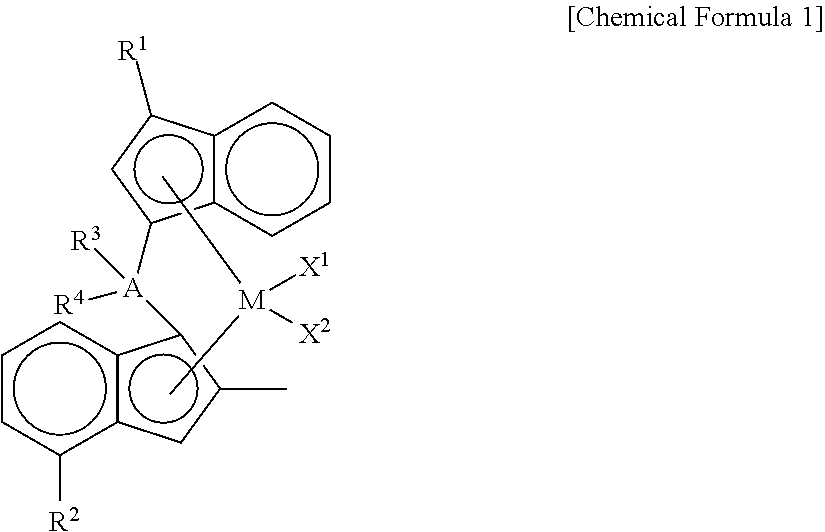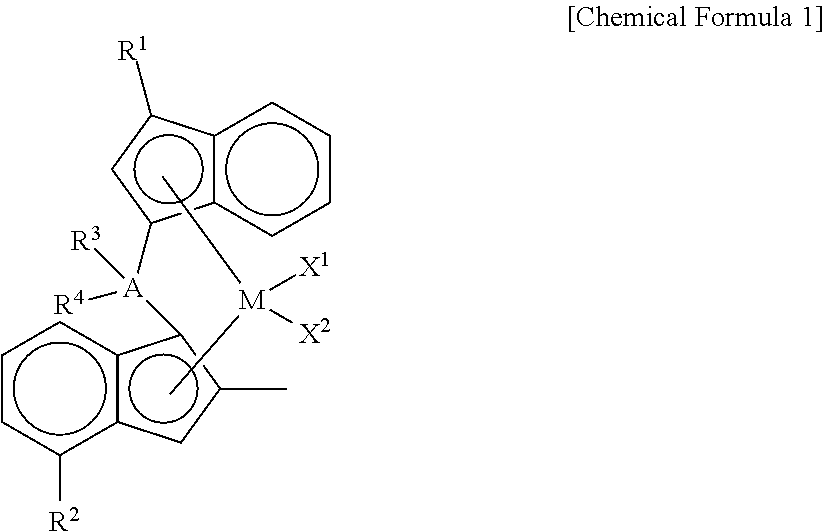Novel Transition Metal Compound and Method for Preparing Polypropylene Using the Same
- Summary
- Abstract
- Description
- Claims
- Application Information
AI Technical Summary
Benefits of technology
Problems solved by technology
Method used
Image
Examples
preparation example 1-1
[0103]
Step 1: Preparation of dimethylsilanediyl(3-phenyl-1H-inden-1-yl)(2-methyl-4-(4-tert-butylphenyl)-1H-indene)
[0104]1 eq of 3-phenyl-1H-indene was dissolved in a mixed solution of toluene / THF (10 / 1 by volume, 0.5 M), and n-BuLi (1.05 eq) was slowly added dropwise thereto at −25° C., followed by stirring at room temperature for 3 hours. Dichlorodimethyl silane (1.05 eq) was added to the reaction product at −10° C., and stirred overnight at room temperature to prepare a mono-Si solution.
[0105]In another reactor, 2-methyl-4-(4-tert-butylphenyl)indene (1 eq) was dissolved in a mixed solution of toluene / THF (5 / 1 by volume, 0.7 M), and n-BuLi (1.05 eq) was slowly added dropwise thereto at −25° C., followed by stirring at room temperature for 3 hours. CuCN (2 mol %) was added to the reaction product and stirred for 30 minutes, and then the mono-Si solution was added thereto. Thereafter, it was stirred overnight at room temperature, worked up with water, and dried to obtain a ligand.
Ste...
preparation example 1-2
[0109]
[0110]Dimethylsilanediyl(3-n-butyl-1H-inden-1-yl)(2-methyl-4-(4-tert-butylphenyl)-1H-inden-1-yl) zirconium dichloride was prepared in the same manner as in Preparation Example 1-1, except that 3-n-butyl-1H-indene was used instead of 3-phenyl-1H-indene in Step 1.
[0111]Pseudo-rac: 7.57 (d, 1H), 7.4-6.8 (m, 10H), 6.61 (s, 1H), 5.67 (s, 1H), 2.86 (t, 2H), 2.16 (s, 3H), 1.58 (m, 2H), 1.42 (s, 3H), 1.33 (s, 9H), 1.4-1.2 (m, 2H), 1.03 (s, 3H), 0.92 (t, 3H) ppm
preparation example 1-3
[0112]
[0113]Dimethylsilanediyl(3-iso-propyl-1H-inden-1-yl)(2-methyl-4-(4-tert-butylphenyl)-1H-inden-1-yl) zirconium dichloride was prepared in the same manner as in Preparation Example 1-1, except that 3-iso-propyl-1H-indene was used instead of 3-phenyl-1H-indene in Step 1.
[0114]Pseudo-rac: 7.58 (d, 1H), 7.3-6.8 (m, 10H), 6.6 (5, 1H), 5.69 (s, 1H), 2.41 (m, 1H), 1.42 (s, 3H), 1.33 (s, 9H), 1.01 (d, 6H), 0.82 (s, 6H) ppm
PUM
| Property | Measurement | Unit |
|---|---|---|
| Temperature | aaaaa | aaaaa |
| Temperature | aaaaa | aaaaa |
| Weight | aaaaa | aaaaa |
Abstract
Description
Claims
Application Information
 Login to View More
Login to View More - R&D
- Intellectual Property
- Life Sciences
- Materials
- Tech Scout
- Unparalleled Data Quality
- Higher Quality Content
- 60% Fewer Hallucinations
Browse by: Latest US Patents, China's latest patents, Technical Efficacy Thesaurus, Application Domain, Technology Topic, Popular Technical Reports.
© 2025 PatSnap. All rights reserved.Legal|Privacy policy|Modern Slavery Act Transparency Statement|Sitemap|About US| Contact US: help@patsnap.com



